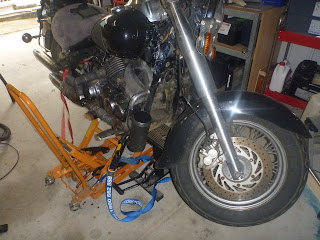As the three occasional readers of this blog may know, I have been experimenting for some time on ways to reduce the effects of wind on the helmet, especially noise and buffeting. Its just an interest to see how much I can learn about this without compromising on safety, protection from bugs and rear-view visibility.
On Monday whilst riding I noticed for the first time that the left-hand-side mirror on the Yamaha sits higher than the right-hand-side. This is due to the combined effects of the different stock Yamaha mounting points as well as blindly installing a matching riser to the thread adaptor when I installed aftermarket mirrors.
Basically, if I had measured the heights at the time, I would have realised that the left hand riser was not needed. The left hand mirror mounting point is different to the right-hand side and about three centimetres higher.
Anyhow, when I arrived home, I removed the left-hand-side riser and the mirrors are closer to level, although not perfectly matched. On this mornings ride, I could detect another lowering in buffeting, not a huge difference as it already is fairly low, but some. This seems to align well with the information from a few sources that indicate that the best way to reduce the effects of rear-view mirrors on air flow towards the body and helmet are:
1. Without compromising visibility, keep the mirrors low and out from the bike as possible.
http://www.stromtrooper.com/general-v-strom-discussion/7596-difference-between-buffeting-turbulence.html and
http://www.stromtrooper.com/general-v-strom-discussion/45457-$18-mirrors-cure-buffeting.html .This does not reduce the buffeting and wind disruption, but places it away from the helmet and body as much as possible.
2. My own observation is to avoid, if possible, a sharp or 90 degree inside corner. Rather, look for mirrors that have a curved edge or even a straight edge from the mount as air flow over the top and inside planes flow a lot smoother. This was my experience with installing Yamaha Tenere mirrors on the Suzuki DR800 and then smaller circular mirrors. To date, the Tenere mirrors were the best ones I have used. To install them I used the Suzuki base mounts and Yamaha stalks.
3. This seems be be congruent with the designs from more expensive and faster bikes. They all have smoother top and inside edges as per the Aprilia ones below:
4. The smaller, the better. Without comprising rear-view visibility, it seems to make sense that the smaller the mirror, the less disruption to the air flow that can occur. I have yet to test this fully. Of course a smaller mirror may have to have a convex lens to provide the full coverage.
5. I suspect, but I am not sure, that if the body of the mirror casing has some shape that helps move the air in a more aerodynamic fashion, this would also help. The casings for the current old GSX-style mirrors are fairly flat, as are DR stock mirrors and it strikes me that these flat surfaces would be pushing the air in a range of uncontrolled directions.










